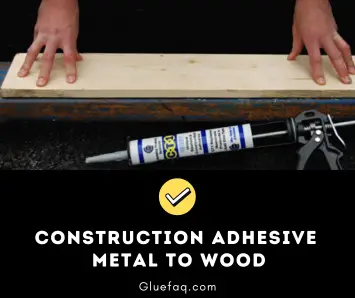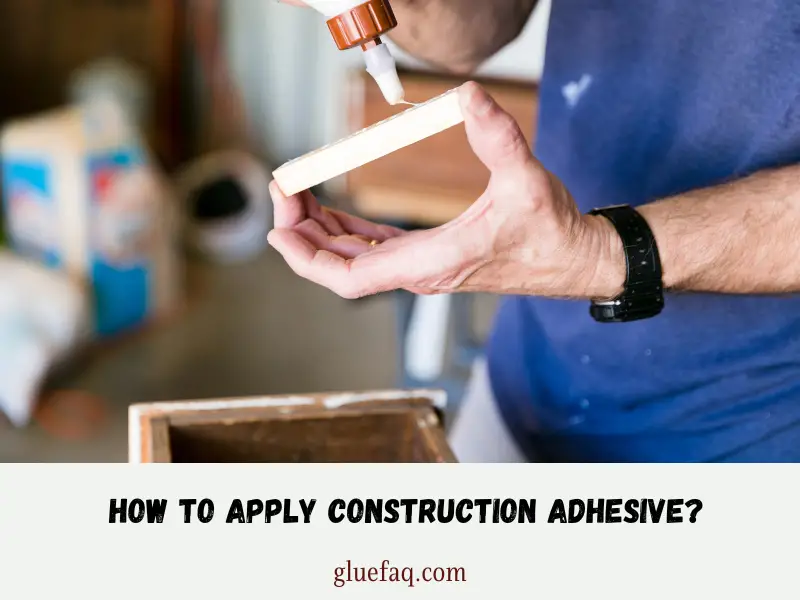Welcome to the ultimate guide on construction adhesive, your go-to solution for bonding metal to wood.
In this comprehensive article, we’ll explore the fascinating world of construction adhesive and discover how it revolutionizes the way we join these two materials. Say goodbye to traditional fasteners and hello to the power of adhesive!

So, let’s dive right in and unlock the secrets to achieving strong, durable, and long-lasting bonds that will withstand the test of time.
Construction Adhesive Metal to Wood
When it comes to metal-to-wood bonding, construction adhesive is the unsung hero. But what exactly is construction adhesive? It’s a versatile adhesive specifically designed to bond a wide range of materials, including metal and wood.
This remarkable adhesive composition ensures a reliable connection that outperforms traditional fastening methods in many ways.

Let’s explore the different types of construction adhesives and how to choose the perfect one for your project.
Types of Construction Adhesive Suitable for Metal-to-Wood Bonding
- All-Purpose Construction Adhesive: A versatile adhesive suitable for various materials, including metal and wood.
- Polyurethane Construction Adhesive: Offers excellent flexibility and durability for metal-to-wood bonding.
- Epoxy Construction Adhesive: Known for its exceptional strength and resistance, ideal for heavy-duty applications.
Preparing the Surfaces
Before we embark on the bonding journey, it’s crucial to prepare the surfaces properly. Cleaning the metal and wood surfaces ensures a clean canvas for the adhesive to work its magic.
Remove any rust, paint, or contaminants that might hinder the bond. Additionally, sand and smooth surfaces create an ideal environment for adhesion.
Applying Construction Adhesive
Now that our surfaces are pristine, it’s time to apply the construction adhesive. Applying adhesive evenly and avoiding excess is the key to success.

Choose the appropriate application method, such as a caulking gun or adhesive dispenser, to ensure precise and controlled application.
And here’s a pro tip: if you’re working on vertical or overhead applications, consider using adhesive with a non-drip formula for hassle-free bonding.
Read: Top 7 Best Glue for Metal to Wood
Achieving Strong Metal-to-Wood Bonding
Creating a strong bond requires attention to detail. Properly positioning and aligning the materials is crucial for a sturdy connection.
Remember to apply the correct amount of adhesive; too little might result in a weak bond, while excess adhesive can be messy and ineffective.
To enhance the bonding process, consider using clamps to firmly hold the materials together during curing.
Curing and Drying Times
Patience is a virtue when it comes to construction adhesive. Understanding the curing process and allowing sufficient drying time is vital for optimal bonding strength.
Factors such as temperature and humidity can influence the overall drying time. It’s essential to follow the manufacturer’s instructions to ensure the adhesive reaches its maximum strength.
Ensuring Long-Term Durability
We all want our bonds to last a lifetime, and construction adhesive can make it possible. To ensure long-term durability, protect the bonded joint from moisture, heat, and other elements.
Sealing and reinforcing the bond with appropriate measures, such as sealants or reinforcements, can significantly enhance its longevity.
Common Mistakes to Avoid
As with any process, there are pitfalls to be aware of. Let’s explore some common mistakes to avoid during the bonding process:
- Over-application of adhesive: Remember, a little goes a long way. Apply adhesive in moderation for the best results.
- Insufficient surface preparation: Skipping proper surface cleaning and preparation can compromise the bond’s strength.
- Inadequate curing or drying time: Rushing the process may lead to a weaker bond. Give the adhesive the time it needs to fully cure and dry.
Removing or Disassembling the Bonded Materials
Sometimes, we need to separate what was once bonded. To remove or disassemble bonded metal and wood, specific techniques come into play.
Using solvents or adhesive removers can help loosen the bond, and carefully using tools designed for safe separation is crucial.
Applications and Uses
The applications for metal-to-wood bonding with construction adhesive are endless. From simple DIY projects to complex construction scenarios, this adhesive is a game-changer. Let’s explore some exciting examples:
1-Building furniture with metal frames and wooden tabletops
2-Constructing outdoor decks with metal railings and wooden planks
3-Installing metal brackets onto wooden surfaces for added support
Comparing Construction Adhesive to Other Bonding Methods
While traditional mechanical fasteners like nails and screws have their place, construction adhesive offers distinct advantages for metal-to-wood bonding. Let’s compare the two methods:
Construction Adhesive:
- Provides a strong, reliable bond without visible fasteners
- Distributes stress evenly across the bonded area, reducing the risk of wood splitting
- Offers better resistance to vibrations and movement
- Creates a more aesthetically pleasing finish
Mechanical Fasteners:
- Simpler and quicker to install in certain scenarios
- Easier to disassemble or modify the connection if needed
Safety Precautions
Before embarking on any adhesive project, safety should be a top priority. Follow these safety precautions to ensure a secure and worry-free bonding experience:
- Ensure proper ventilation in the workspace.
- Wear protective equipment such as gloves and safety glasses.
- Handle and store adhesive products according to the manufacturer’s guidelines.
FAQs About Construction Adhesive Metal to Wood
Yes, construction adhesives can be used for outdoor applications. However, it is important to check the specific product label and ensure that it is designed for outdoor use.
The drying time of construction glue can differ based on the product and surroundings. Typically, it takes around 24 to 48 hours for the glue to completely dry. However, it’s best to follow the instructions provided by the manufacturer for the particular product you’re using, as drying times may vary.
Construction adhesive can typically be used on painted surfaces. However, it is important to ensure that the adhesive is compatible with the type of paint you are working with. Some adhesives may not bond well to certain types of paint finishes, so it is advisable to test a small area first or consult the adhesive manufacturer for guidance.
The shelf life of construction adhesive can vary depending on the brand and formulation. Typically, most construction adhesives have a shelf life of approximately one to two years when stored in their original, unopened containers. However, it is recommended to check the product label or contact the manufacturer for specific information regarding the shelf life of the adhesive you are using.
Using clamps when bonding metal to wood with adhesive is generally recommended. Clamping helps to ensure proper contact between the surfaces and promotes a strong bond. It also helps to keep the materials in place while the adhesive cures. Follow the manufacturer’s instructions for the specific adhesive you are using, as they may provide recommendations on clamping pressure and duration.
Final Words
Congratulations! You’ve now gained a comprehensive understanding of construction adhesive and its remarkable bonding capabilities for metal to wood.
By following the right steps, preparing the surfaces diligently, and allowing adequate curing time, you can achieve strong, durable bonds that will withstand the test of time.
So, why stick to the conventional when construction adhesive opens up a world of possibilities?
